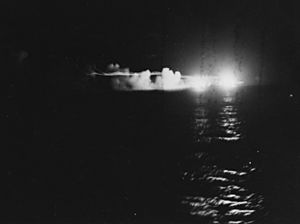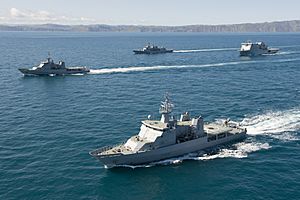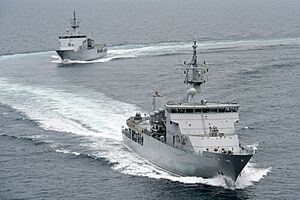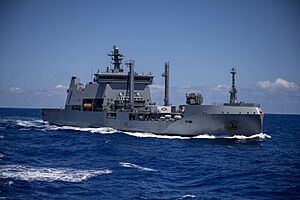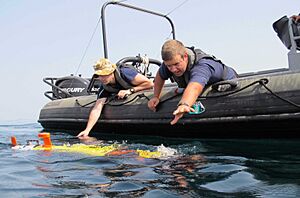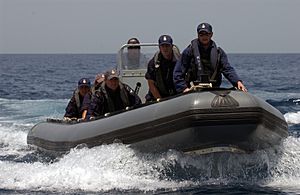Royal New Zealand Navy facts for kids
Quick facts for kids Royal New Zealand Navy |
|
|---|---|
| Te Taua Moana o Aotearoa (Māori) | |
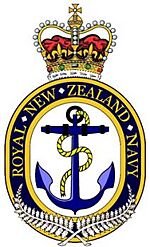
Badge of the Royal New Zealand Navy
|
|
| Founded | 1 October 1941 |
| Country |
|
| Type | Navy |
| Role | Naval warfare |
| Size |
|
| Part of | New Zealand Defence Force |
| Garrison/HQ | Devonport Naval Base |
| Colours | Red White |
| March | Quick – "Heart of Oak" Slow – "E Pari Ra" |
| Mascot(s) | Anchor |
| Anniversaries | 1 October 1941 (founded) |
| Fleet |
|
| Engagements | |
| Website | https://www.nzdf.mil.nz/navy/ |
| Commanders | |
| Governor-General and Commander-in-Chief | Dame Alcyion Cynthia Kiro |
| Chief of Defence Force | Air Marshal Tony Davies |
| Chief of Navy | Rear Admiral Garin Golding |
| Deputy Chief of Navy | Commodore Andrew Brown |
| Insignia | |
| Logo |  |
| Naval ensign | 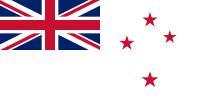 |
| Naval jack | 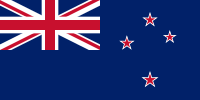 |
The Royal New Zealand Navy (RNZN), also known as Te Taua Moana o Aotearoa (Sea Warriors of New Zealand), is the part of the New Zealand Defence Force that protects New Zealand's waters. It currently has eight ships. The Navy started in 1913 and grew slowly. In 1939, one of its ships, HMS Achilles, fought in a famous battle against a German ship called Graf Spee.
Contents
The first recorded sea battle in New Zealand happened in 1642. Māori warriors in war canoes attacked sailors from Abel Tasman's ships.
The New Zealand Navy did not become a separate military force until 1941. Before that, the British Royal Navy helped protect New Zealand. James Cook first arrived in 1769. Royal Navy ships visited often from the late 1700s. They even helped in the New Zealand Wars, for example, by using gunboats to attack fortified Māori villages.
World War I and Between the Wars
In 1909, New Zealand helped pay for a large warship called HMS New Zealand for the Royal Navy. This ship fought in World War I in Europe. In 1913, the Naval Defence Act 1913 created the New Zealand Naval Forces. These forces were still part of the Royal Navy.
The first ship given to New Zealand was the cruiser HMS Philomel. It helped New Zealand forces take over the German colony of Samoa in 1914. Philomel later served in other parts of the world. By 1917, it was too old for fighting. It became a training ship in Auckland in 1921.
From 1921 to 1941, the New Zealand naval force was called the New Zealand Division of the Royal Navy. During this time, it operated 14 ships. These included the cruisers HMS Achilles and HMS Leander.
World War II and Becoming the RNZN
When Britain declared war on Germany in 1939, New Zealand joined the war at the same time.
HMS Achilles took part in the first big naval battle of World War II. This was the Battle of the River Plate in December 1939. Achilles and two other British cruisers badly damaged the German warship Admiral Graf Spee. The German captain then sank his own ship to save his crew.

Achilles later moved to the Pacific Ocean. It worked with the United States Navy (USN). It was damaged by a Japanese bomb but was repaired. It then served with the British Pacific Fleet until the war ended.
On 1 October 1941, the New Zealand Division of the Royal Navy officially became the Royal New Zealand Navy (RNZN). This showed that New Zealand's navy was now mostly independent. From then on, New Zealand ships were called HMNZS (His/Her Majesty's New Zealand Ship).
HMNZS Leander helped transport New Zealand troops in 1940. It then served in the Mediterranean and Indian Ocean. In 1941, Leander sank an Italian ship. In 1943, it returned to the Pacific. It helped destroy a Japanese ship but was badly damaged by torpedoes. It was repaired after the war.
The RNZN grew much larger during the war. By the end, it had over 60 ships. These ships fought alongside British and Commonwealth forces. They also helped defend New Zealand from German ships and the threat of Japanese invasion. In 1943, the cruiser HMS Gambia joined the RNZN as HMNZS Gambia. Most RNZN ships joined the British Pacific Fleet in 1944. They took part in battles near Japan. In August 1945, HMNZS Gambia represented New Zealand at the surrender of Japan.
After World War II
In April 1947, some sailors on four RNZN ships and two shore bases protested. This led to a shortage of sailors. It forced the RNZN to remove one of its powerful warships, Black Prince, from service. This slowed down the Navy's growth for about ten years.
RNZN ships also fought in the Korean War. In June 1950, New Zealand sent two frigates, Tutira and Pukaki, to Korea. They joined other Commonwealth forces and helped the US Navy. They performed shore raids and bombarded targets on land. Other RNZN frigates also joined the fight. Only one RNZN sailor died during this conflict.
The Navy later helped in the Malayan Emergency and the Indonesia-Malaysia confrontation. These were the last big operations where the RNZN worked closely with the Royal Navy.
Until the 1960s, the RNZN used the same flag as the British Royal Navy. But after 1945, New Zealand wanted its own identity. So, in 1968, the RNZN adopted its own flag. It still has the British flag in one corner, but it shows the Southern Cross stars, like on New Zealand's national flag.
Since 1946, the Navy has patrolled New Zealand's waters to protect fisheries. It also helps with scientific work in Antarctica.
One famous role of the RNZN was in 1973. The frigates Canterbury and Otago were sent to Moruroa Atoll. They were protesting against French nuclear tests. The ships went into the area where the bombs might explode. Both ships saw one air test each. This made France change to testing bombs underground.
In May 1982, the frigate Canterbury was sent to the Persian Gulf to help the Royal Navy during the Falklands War. It took over from a British frigate so that ship could go to the South Atlantic.
After the Cold War
After the Cold War, the RNZN had four frigates. But because it was expensive to replace them, the Navy decided to have only two. There was a lot of discussion about whether to buy more frigates.
Since the 1990s, the RNZN has often worked in the Middle East. RNZN ships helped protect neutral ships during the Iran–Iraq War. Frigates also took part in the first Gulf War and Operation Enduring Freedom. The RNZN has also been important in conflicts in the Pacific. Naval forces helped in the Bougainville, Solomon Islands and East Timor conflicts in the 1990s. The RNZN often joins United Nations peacekeeping missions.
The RNZN's survey ship, HMNZS Resolution, was used to map the sea around New Zealand. It was replaced by HMNZS Manawanui (2019), which started service in 2019.
In October 2021, HMNZS Te Kaha sailed through the South China Sea with a UK naval group. This showed New Zealand's support for free international travel through these waters. In June 2023, HMNZS Te Mana was approached by Chinese navy ships and helicopters near the Spratly Islands.
In September 2024, Defence Minister Judith Collins confirmed that HMNZS Aotearoa sailed through the Taiwan Strait with an Australian ship. China said it handles foreign warships in the strait according to its laws. On 29 September 2024, HMNZS Aotearoa joined a joint patrol with ships from Australia, the Philippines, Japan, and the United States in the disputed South China Sea.
On 5 October 2024, HMNZS Manawanui ran aground and sank off the coast of Samoa. It was surveying a reef during a storm. This was the first RNZN ship lost in peacetime. A naval inquiry in April 2025 found that human errors caused the sinking. On 19 January 2025, Judith Collins confirmed Manawanui would not be replaced. Instead, HMNZS Otago (P148) took on its role, though it lacks some special equipment.
On 6 May 2025, Defence Minister Collins announced that the government would spend NZ$2 billion (US$1.2 billion) to buy new helicopters for the Navy.
Ships and Aircraft
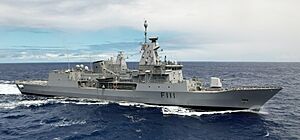
Current Fleet
The Combat Force has two Anzac-class frigates: HMNZS Te Kaha and HMNZS Te Mana. Two more frigates were planned but were cancelled. HMNZS Te Kaha started service in 1997. HMNZS Te Mana started service in 1999. Both ships had their systems upgraded in 2020 and 2022.
The Patrol Force has two offshore patrol vessels (OPVs) and two inshore patrol vessels (IPVs). These ships patrol New Zealand's large Exclusive Economic Zone. They also help other government groups like the Department of Conservation and the Police. The Patrol Force includes:
- 2 Protector-class offshore patrol vessels (HMNZS Otago and HMNZS Wellington)
- 2 Lake-class inshore patrol vessels (HMNZS Taupo and HMNZS Hawea)
- HMNZS Canterbury: A multi-role ship that started service in 2007.
- HMNZS Aotearoa: A ship that refuels other ships, commissioned in 2020.
Littoral Warfare Support
The Littoral Warfare Support Force included HMNZS Manawanui, a dive and survey ship. It sank in October 2024. HMNZS Matataua is a land-based unit. It has groups for surveying the sea and for diving to clear explosives. They help keep harbours and coastal waters safe. They also help the NZ Police with underwater searches.
Aviation
The Royal New Zealand Air Force operates eight Kaman SH-2G(I) Super Seasprite helicopters. These helicopters are flown by RNZN aviators. They are used for:
- Watching over areas
- Fighting on the surface of the water
- Fighting underwater
- Delivering supplies
- Search and rescue
- Medical help
- Training
- Helping other government groups
Other Vessels
The RNZN also uses smaller, non-commissioned boats. These are for training, support, and coastal work. They include:
- Three training sail training yachts
- Two Landing Craft Mechanised (used on HMNZS Canterbury)
- Three Littoral Manoeuvre Craft
- Two hydrographic and diving support boats
- One VIP (Admiral's) Barge
- Nine Zodiac Hurricane RHIBs
- 26 Zodiac Milpro J3 RHIBs
Unmanned Vehicles
The RNZN uses autonomous underwater vehicles (AUVs). These are robots that can explore underwater. Since late 2024, they also have two uncrewed surface vessels called Tahi and Rua.
| Autonomous Underwater Vehicle | Quantity |
|---|---|
| REMUS 100 | 6 |
| REMUS 300 | 4 |
The RNZN does not use drones on its ships yet.
Future Plans
The government has plans for new equipment and ships for the RNZN in the future.
Protecting New Zealand
The main job of the New Zealand Defence Force (NZDF) is to protect New Zealand from outside threats. This includes its people, land, waters, and resources. The RNZN helps with the sea-based parts of this mission.
The NZDF aims to:
- Keep New Zealand safe.
- Reduce risks from problems in other countries.
- Promote New Zealand's values by joining international security groups.
- Be ready for future security challenges.
Working with Other Countries
The RNZN helps prevent problems in New Zealand by being present in other countries. It helps with rebuilding in troubled places. For example, problems in the Pacific Islands can affect New Zealand. So, keeping the South Pacific stable is important to New Zealand. The Navy has helped with peacekeeping in East Timor, Bougainville, and the Solomon Islands.
Helping Civilians

The Navy also helps other government groups. This includes patrolling New Zealand's fishing waters. They also transport people and supplies to islands. They support the New Zealand Customs Service. The Navy used to map the sea for civilian use. Now, it mainly focuses on mapping for military purposes.
Since 2001, the two Anzac-class frigates have been part of the United States' Operation Enduring Freedom. They have patrolled the Persian Gulf and supported efforts in Afghanistan.
The RNZN regularly operates in the Southwest Pacific and Southern Ocean, down to Antarctica. They also go to other places when the New Zealand government directs them to.
As of June 30, 2022, the RNZN had 2,219 full-time personnel. It also had 611 Naval Reserve personnel.
Reserves
When people leave the RNZN, they can choose to serve four years in the Royal New Zealand Naval Reserve.
Volunteer Reserve
The main reserve part of the RNZN is the Royal New Zealand Naval Volunteer Reserve (RNZNVR). It has four units in Auckland, Wellington, Christchurch, and Dunedin:
- HMNZS Ngapona: Auckland
- HMNZS Olphert: Wellington
- HMNZS Pegasus: Christchurch
- HMNZS Toroa: Dunedin
Civilians can join the RNZNVR in different roles. Former full-time Navy personnel can also rejoin.
Training
New sailors start with an 18-week basic training course. After that, they learn skills for their chosen job. New officers complete 22 weeks of training. Then they begin their special training.
Regular Funding
The RNZN gets its money from the Parliament of New Zealand. The New Zealand Defence Force pays for staff, operations, and other costs. Money is given for specific goals.
Big Projects
The Ministry of Defence buys major military equipment. This funding is separate.
The Navy Museum is in Devonport, Auckland. It has important collections of naval items and records.
HMNZS Irirangi was a Navy communication station at Waiouru. It operated from 1943 to 1993.
Uniforms and Ranks
RNZN uniforms look very similar to those of the British Royal Navy. However, RNZN personnel wear "NEW ZEALAND" on their uniforms. The RNZN also uses the rank of Ensign for its lowest officer rank.
Rank Structure and Insignia
| Rank group | General/flag officers | Senior officers | Junior officers | Officer cadet | ||||||||||||||||||||||||||||||||
|---|---|---|---|---|---|---|---|---|---|---|---|---|---|---|---|---|---|---|---|---|---|---|---|---|---|---|---|---|---|---|---|---|---|---|---|---|
  |
  |
  |
  |
 |
 |
 |
 |
 |
 |
 |
||||||||||||||||||||||||||
| Admiral of the fleet | Vice admiral | Rear admiral | Commodore | Captain | Commander | Lieutenant commander | Lieutenant | Sub lieutenant | Ensign | Midshipman | ||||||||||||||||||||||||||
| Rank group | Senior NCOs | Junior NCOs | Enlisted | |||||||||||||||||||||||||||||||||
|---|---|---|---|---|---|---|---|---|---|---|---|---|---|---|---|---|---|---|---|---|---|---|---|---|---|---|---|---|---|---|---|---|---|---|---|---|
 |
 |
 |
 |
 |
 |
|||||||||||||||||||||||||||||||
| Warrant officer | Chief petty officer | Petty officer | Leading hand | Able rate | Ordinary rate | |||||||||||||||||||||||||||||||
See also
 In Spanish: Armada Real Neozelandesa para niños
In Spanish: Armada Real Neozelandesa para niños
- Military history of New Zealand
- New Zealand Sea Cadet Corps
- New Zealand military ranks
- New Zealand Defence College
- Logistics ships of the Royal New Zealand Navy
- List of individual weapons of the New Zealand armed forces
- List of ships of the Royal New Zealand Navy


